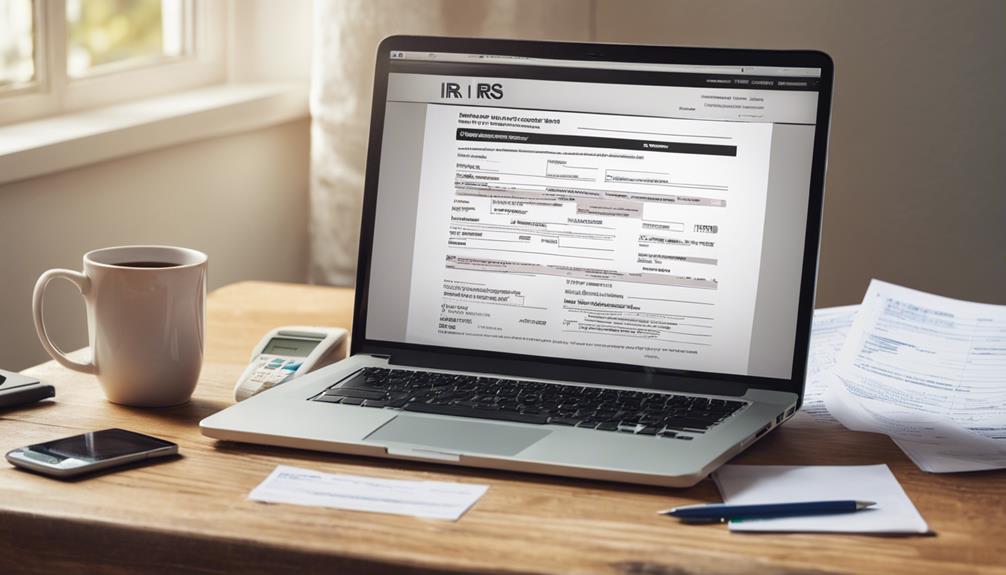If you're worried about identity theft impacting your tax return, applying for an IRS Identity Protection PIN (IP PIN) might be a smart move. This six-digit number helps verify your identity and adds an extra layer of security when you file your taxes. However, not everyone qualifies, and the application process can vary. You'll need to gather specific documents and decide whether to apply online or by mail. Understanding these steps can make all the difference, especially when you consider the consequences of not having this protection in place. So, what should you know first?
Key Takeaways
- Check eligibility by confirming any prior identity theft incidents reported to the IRS or federal agencies.
- Apply online through the IRS website by providing personal information and creating an account for secure management.
- For mail applications, gather necessary documents and submit IRS Form 15227 alongside identity verification materials.
- Renew your IP PIN annually to ensure ongoing protection, typically around late January each year.
- Keep your IP PIN confidential and secure to prevent unauthorized access and potential fraudulent tax filings.
Understanding the IRS IP PIN

An IRS Identity Protection PIN, or IP PIN, is a six-digit number that the IRS assigns to help protect your tax return from identity theft. When you apply for an IP PIN, you're taking a proactive step to safeguard your sensitive information. The IP PIN application process can be done online or through the mail, depending on your preference and circumstances. You'll need to provide personal information, like your Social Security number, to verify your identity.
Once you receive your IP PIN, it's essential to use it every time you file your taxes. It helps confirm that only you can file your return, substantially reducing the risk of fraud. Keep in mind that you must renew your IP PIN each year, as it changes annually. The IP PIN renewal options are generally straightforward. You can renew it online, or if you didn't receive a new PIN, you can request a replacement. Staying on top of your IP PIN ensures your tax return remains secure, helping you maintain peace of mind during tax season.
Eligibility Requirements
To qualify for an IRS Identity Protection PIN, you'll need to meet specific eligibility requirements. If you've experienced prior identity theft incidents or been a victim of fraud, you may be eligible. Additionally, your filing status can impact your ability to obtain an IP PIN, so it's important to understand these factors.
Prior Identity Theft Incidents
If you've experienced identity theft in the past, you may qualify for an IRS Identity Protection PIN. This PIN helps you secure your tax return from unauthorized access, ensuring that your refund goes to you. To be eligible, you need to have had prior identity theft incidents reported to the IRS or another federal agency. It's pivotal that you take identity theft protection actions, such as filing a police report or submitting a complaint to the Federal Trade Commission (FTC).
When you apply for the PIN, you'll need to verify your identity through their online system. This process includes providing personal information and answering security questions related to your past incidents. Make sure you have all relevant documentation ready to streamline your application.
Additionally, being a victim of identity theft will not only grant you access to the PIN but also help you establish a secure process for future tax filings. If you believe you're eligible, don't hesitate to take action. Protecting your identity is essential, and obtaining this PIN is a proactive step towards safeguarding your financial information.
Victim of Fraud
Having a prior identity theft incident can open the door to obtaining an IRS Identity Protection PIN, but being a victim of fraud also makes you eligible. If you've experienced fraud, whether it's from a data breach, phishing scam, or any other fraudulent activity, your tax identity concerns are valid. The IRS recognizes these situations and offers you the opportunity to secure your tax filings with a PIN.
To qualify, you'll need to demonstrate that you're a victim of fraud. This could involve providing documentation or evidence that supports your claim. Once you've established your eligibility, you can apply for your Identity Protection PIN through the IRS website or by contacting them directly.
Having this PIN enhances your personal information security, ensuring that only you can file your tax return. It acts as a safeguard against future issues related to tax identity theft. By taking this step, you're actively protecting yourself and your financial information from further fraudulent activity. Remember, staying vigilant and proactive about your personal information security is essential in today's digital age.
Filing Status Considerations
Understanding your filing status is paramount when applying for an IRS Identity Protection PIN, as it influences your eligibility. The IRS recognizes several filing status options: Single, Married Filing Jointly, Married Filing Separately, Head of Household, and Qualifying Widow(er). Each status has specific criteria that can affect your application process.
When you're choosing your filing status, make sure that it accurately reflects your situation. For instance, if you're married but decide to file separately, you may face limitations in certain tax benefits, which could impact your eligibility for the PIN. If you're a victim of identity theft, using the proper filing status is indispensable, as it can affect how the IRS processes your tax return and your PIN request.
Certain filing status options, like Head of Household, may offer additional benefits that could help in your application. Be sure to review the IRS guidelines thoroughly to confirm you meet the requirements for the status you select. By understanding these nuances, you can navigate the application process more effectively and safeguard your tax return with an IRS Identity Protection PIN.
How to Apply Online

Applying online for your IRS Identity Protection PIN (IP PIN) is a straightforward process that guarantees the security of your tax return. To begin, visit the IRS website and locate the online application section specifically for the IP PIN. You'll need to provide some personal information, including your Social Security number, date of birth, and filing status. Make certain all your details are accurate to avoid any delays.
During the online application process, you'll also need to create an account if you don't have one already. This account is essential for managing your IP PIN and securing identity information. After submitting your application, the IRS will review it, and if everything checks out, you'll receive your IP PIN via email or through your online account.
Keep in mind that the IP PIN is valid for one calendar year, so you'll need to apply for a new one each year. By following these steps, you can effectively protect your tax return from identity theft and safeguard your sensitive information. Don't wait—start the application process today to bolster your tax security!
Applying by Mail
If you prefer to apply for your IRS Identity Protection PIN by mail, you'll need to meet certain eligibility criteria first. Make sure you gather the required documentation before starting the mailing process. Understanding these steps will help guarantee your application goes smoothly.
Eligibility Criteria Overview
To qualify for an IRS Identity Protection PIN when applying by mail, you must meet specific eligibility criteria. First, you need to have experienced a past identity theft incident that impacted your tax information. The IRS requires you to provide details about the incident during the application process.
Next, you must meet the income threshold set by the IRS. Your adjusted gross income (AGI) must fall within a specific range to guarantee you're eligible for this program. This requirement helps the IRS streamline applications and focus on those most vulnerable to identity theft.
Additionally, you'll need to complete a thorough identity verification process. This typically includes providing personal information such as your name, Social Security number, and any relevant tax information from previous returns. The IRS uses this data to validate your identity and assess your eligibility for the PIN.
Keep in mind that fulfilling these criteria is essential for receiving your IRS Identity Protection PIN. By meeting these standards, you can better protect yourself against tax-related identity theft and secure a smoother tax filing experience in the future.
Required Documentation Checklist
Gathering the right documents is essential when you're applying for an IRS Identity Protection PIN by mail. You'll need to guarantee that you meet the personal information requirements and complete the identity document verification process. Here's a checklist to help you stay organized:
| Document Type | Purpose | Notes |
|---|---|---|
| Government-issued ID | To confirm your identity | Must include photo |
| Social Security Number | To verify your personal information | Needed for tax purposes |
| Recent tax return | To support your application | Ensure it's the most recent filed |
| Utility bill or bank statement | To show your current address | Must be dated within the last 12 months |
| IRS Form 14039 | To report identity theft if applicable | Required if you believe your identity was compromised |
Having these documents ready can make the process smoother. Double-check that everything meets the guidelines to avoid delays. Remember, proper identity document verification is critical to safeguard your tax return and secure your financial future!
Mailing Process Steps
When you're ready to apply for your IRS Identity Protection PIN by mail, it's crucial to follow the correct steps to confirm your application is processed efficiently. Start by gathering all required documentation, including your completed Form 15227, which is necessary for your application. Ensure you have valid identification, like your driver's license or Social Security card, as these will meet the submission requirements.
Next, double-check that you've filled out the form completely and accurately. Incomplete or incorrect information can delay your application processing. Once you're confident everything is in order, place your documents in a secure envelope. It's a good idea to use a traceable mailing service, so you can confirm that your application arrives safely.
After mailing your application, keep an eye on your mail for any updates from the IRS. If they need more information, they'll reach out, so be prepared to respond promptly. By following these steps and adhering to the submission requirements, you can streamline your application process and get your IRS Identity Protection PIN as quickly as possible.
What to Expect After Applying

After applying for an IRS Identity Protection PIN, you can expect a few key steps in the process. First, you'll want to keep an eye on your processing application status. The IRS typically takes about a few weeks to review your application and determine your eligibility.
- Receiving Confirmation Letter: Once your application is processed, you'll receive a confirmation letter from the IRS. This letter will provide important details about your IP PIN, ensuring you know what to do next.
- IP PIN Issuance: If your application is approved, you'll receive your unique IP PIN. This six-digit number is essential for safeguarding your tax return from identity theft.
- Ongoing Updates: After you receive your IP PIN, it's important to stay informed. The IRS will send you a new IP PIN each year, so always watch for that correspondence.
Renewing Your IP PIN
Renewing your IRS Identity Protection PIN (IP PIN) is essential for maintaining the security of your tax return each year. The IRS issues an IP PIN annually, so you'll need to renew it to keep your protections in place. Typically, the renewal timeline begins at the end of the tax season, around late January, allowing you to obtain your new PIN before filing your next return.
It's important to note that your renewal frequency is once a year. If you've been assigned an IP PIN, you must obtain a new one each tax season to safeguard your information effectively. Make sure to keep track of when you need to renew, as missing this deadline can lead to complications when you file your return.
To renew your IP PIN, you can use the IRS online tool, or you can contact the IRS directly. It's a straightforward process, so don't hesitate to take action when the time comes. By staying on top of your renewal, you'll guarantee your identity remains protected against tax-related fraud, giving you peace of mind each filing season.
Lost or Forgotten PIN

If you've lost or forgotten your IRS Identity Protection PIN (IP PIN), don't worry—there are steps you can take to retrieve it. First, you'll want to request a replacement PIN from the IRS. This process isn't as challenging as it sounds. Here's what you need to do:
- Visit the IRS website: Go to the Identity Protection page to find the reapplying procedure.
- Complete the required form: Fill out IRS Form 15227, which is necessary for requesting a replacement.
- Provide identification: Be ready to verify your identity, as the IRS needs to ensure that you're the rightful owner of the PIN.
Once you've submitted your request, the IRS will send you a new IP PIN via the address they have on file. It may take a few weeks, so plan accordingly. Remember, keeping your PIN secure is essential for protecting your tax return from identity theft. If you have any questions during the process, don't hesitate to reach out to the IRS for assistance.
Using Your IP PIN
Now that you have your IP PIN, it's vital to understand its benefits and how to apply it effectively. This unique identifier not only protects your tax return but also helps you stay ahead of identity theft. Let's explore how you can make the most of your IP PIN to secure your finances.
Understanding IP PIN Benefits
Why should you consider using an IRS Identity Protection PIN (IP PIN) for your tax return? The benefits are considerable, especially if you have concerns about identity theft. An IP PIN enhances your security and helps ease your ip pin privacy concerns.
- Identity Theft Protection: By using an IP PIN, you create an extra layer of security against tax-related identity theft. Only you can use this PIN to file your tax return, making it harder for fraudsters to claim your refund.
- Faster Processing: When you provide your IP PIN during the ip pin registration process, the IRS can process your return more rapidly. This helps you get your refund sooner and reduces the likelihood of errors.
- Peace of Mind: Knowing that you have an IP PIN offers peace of mind. It shows you're taking proactive steps to protect your sensitive information, ensuring that your tax return is secure.
Incorporating an IP PIN into your tax filing can greatly bolster your defenses against identity theft, making your tax experience smoother and safer.
Applying for Your IP PIN
Applying for your IRS Identity Protection PIN (IP PIN) is a straightforward process that can substantially improve your tax security. To start, you'll need to visit the IRS website and use the Get an IP PIN tool. You must provide personal information, including your Social Security number and filing requirements from your latest tax return. Make sure you have access to your email or mobile phone, as the IRS will send you a verification code.
Once verified, you can create your account and receive your IP PIN. If you've been a victim of identity theft, you might automatically receive an IP PIN each year, but applying guarantees you get one if you're not. Remember, your IP PIN will change annually, so you'll need to apply each year or retrieve it from the IRS if you're already enrolled.
This identity protection measure is indispensable for preventing fraudulent tax returns from being filed in your name. By following these steps, you'll enhance your tax security and confirm your filing process remains smooth and secure.
Using IP PIN Effectively
Using your IRS Identity Protection PIN (IP PIN) effectively is crucial for safeguarding your tax return. To guarantee proper IP PIN usage, follow these steps:
- Keep Your IP PIN Secure: Treat your PIN like cash. Don't share it with anyone, and store it in a safe place. If someone gets hold of your PIN, they could file a fraudulent return in your name.
- Use Your PIN Every Tax Season: Every year, the IRS issues a new IP PIN. Ensure you use the current year's PIN when filing your taxes, as using an old one can lead to delays or complications.
- Report Any Issues Promptly: If you suspect your IP PIN has been compromised or you encounter problems while filing, report it to the IRS immediately. Timely action can prevent further issues.
Protecting Your IP PIN

Protecting your IP PIN is essential for maintaining the security of your tax information. This unique identifier helps you secure your identity and prevents fraud when filing your tax return. To keep your IP PIN safe, never share it with anyone, not even friends or family. Treat it like a password: the more private you keep it, the better.
Store your IP PIN in a secure location, such as a locked file or a password manager. Avoid writing it down in places where it could be easily found, like on sticky notes or in your wallet. If you suspect that someone may have accessed your IP PIN, contact the IRS immediately to report the issue and take necessary actions.
Regularly review your financial accounts for unusual activity. If you notice anything suspicious, act quickly to secure your identity. Remember, the key to preventing fraud lies in your vigilance. Always be cautious about sharing personal information online or over the phone, especially with unsolicited contacts. By taking these proactive steps, you can effectively protect your IP PIN and safeguard your tax information from potential threats.
Additional Resources
Staying informed about resources that can help you manage your IRS Identity Protection PIN is essential for your security. Utilizing these resources not only enhances your data security but also strengthens your identity verification process.
- IRS Identity Protection Resources: The IRS website provides detailed information about the IP PIN program, including how to apply and manage your PIN. Regularly check for updates to stay informed.
- Credit Monitoring Services: Consider subscribing to a credit monitoring service. These services can alert you to any unusual activity involving your credit report, which is indispensable for maintaining your identity security.
- Identity Theft Protection Companies: Look into identity theft protection services that offer full monitoring and recovery services. These can provide an extra layer of protection in case of a data breach.
